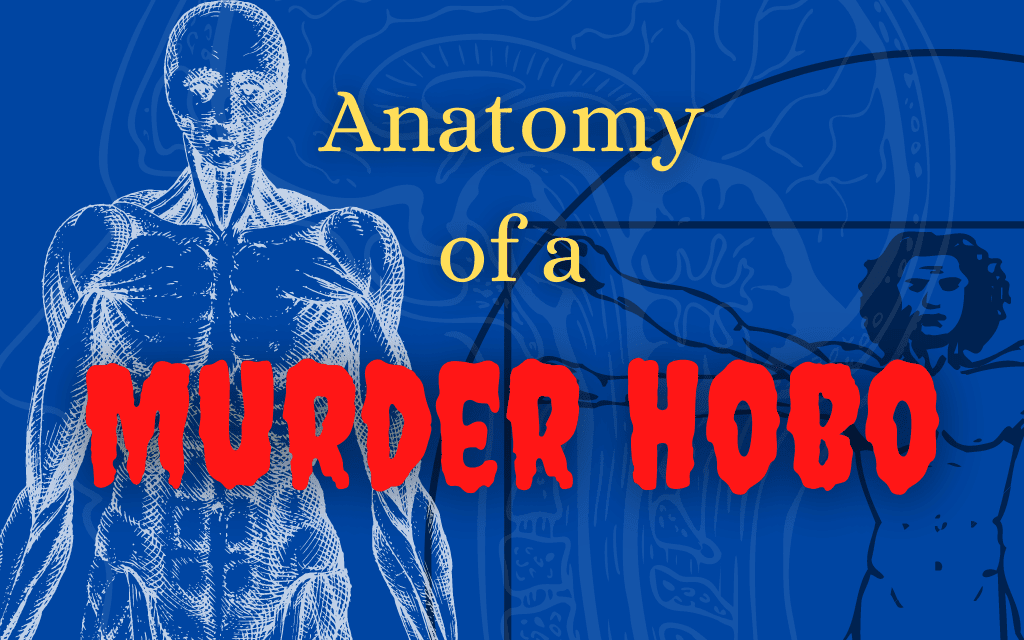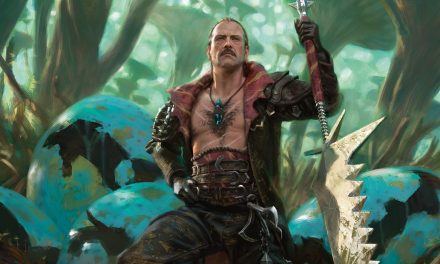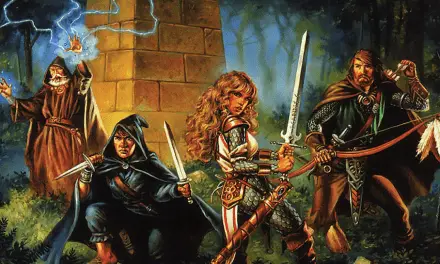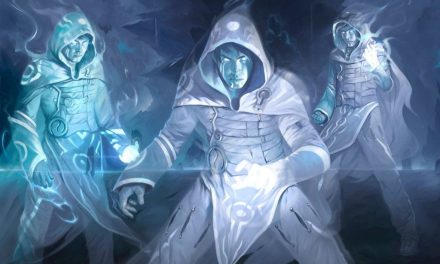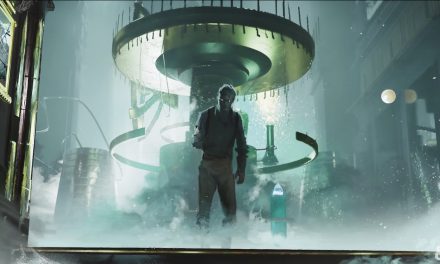One of the most dangerous beings that you can encounter in Dungeons & Dragons isn’t found in the Monster Manual.
This is a being without stats. The smallest word or most subtle movements can provoke it to attacking. Fueled by some kind of rage (and Mountain Dew), it indiscriminately slaughters all who cross its path without hesitation.
The scariest part?
It could be sitting right next to you at the game table…
Gather your nerves and put on your best David Attenborough impression as we take a look at this terrifying creature. While few will even speak its name, we’re going to do exactly that…
This is the Anatomy of a Murderhobo.
What is a Murderhobo?
Let’s start by outlining what a Murderhobo actually is.
In short, a Murderhobo is a character that has no kind of homebase or attachments and wanders around acquiring as much loot as possible. Definitively, they further their goals by answering most or all situations with violence whether called for or not.
The name Murderhobo itself is meant to be a humorous take on what is commonly regarded as a problematic playstyle.
Because characters that fit the Murderhobo trope respond to any situation with violence, they can severely derail a D&D campaign.
While it’s expected that adventurers will fight fierce monsters and dangerous villains throughout the adventure, a shopkeeper that won’t give a discount on their wares is hardly either of those things. Thus we get the difference between heroic adventurers and Murderhobos.
Hacking, slashing, and blasting their way through the game world, Murderhobos commonly become a problem for the party both in and out of the game.
But here’s the thing… That definition isn’t exactly perfect.
If you take the definition of a Murderhobo exactly at face value, it’s pretty accurate to all adventurers. This is especially true in the lower levels when the party is trying to find their footing in the world!
At these levels, the party doesn’t have any kind of keep that they can use as their homebase. They must struggle and fight their way up in the world as they gain experience and treasure. Through interacting with the world, they can begin to make connections with NPCs and further the story.
That experience is expected of a party of low-level adventurers! If nothing else, it’s almost a Rite of Passage!
With that having been said, there’s some important nuance that we need to cover before we go any further…
An Important Distinction
Where people (especially Dungeon Masters) complain about Murderhobos is when it’s problematic. By that I mean this behavior derails the campaign and works against the group’s idea of a fun campaign.
Consider the different types of players. There’s absolutely nothing wrong with enjoying a combat-heavy campaign!
Some groups have the most fun just meeting up, rolling dice, fighting monsters, and taking their loot. These “beer and pretzels” type games can be a ton of fun and harken back to D&D’s roots as a game.
But this is exactly why it’s so incredibly important to have a session zero. Especially as a DM, you have to know what type of fun your players are showing up for.
Related: I’ve got a follow-up article to this one explaining how DM’s can deal with Murderhobos.
For now, just know that Murderhobo-ism isn’t exactly working against D&D as a game. It’s only when Murderhobo behaviors are working against the type of game that the group is playing that it becomes problematic.
Maybe it’s a small nuance, but I think it’s a very important distinction to make.
Just because someone really enjoys combat and getting shiny loot, that doesn’t mean that they’re a Murderhobo or “playing D&D wrong.”
Where it becomes problematic is if the Murderhobo’s fun is coming at the expense of everyone else at the table’s fun.
Murderhobo Characteristics
Murderhobos take many forms and it’s rare that two are exactly the same. However, there are some common characteristics that most Murderhobos share.
Now, just because a character shows these characteristics that doesn’t mean they’re a Murderhobo. They are, however, commonly found in Murderhobos.
Murderhobos Do Not Engage
Murderhobos will rarely engage with the story. To them, they (and only they) ARE the story.
After all, who cares? It’s just a game, right?
Well, yes, it is a game. But it’s real time that real people are spending to play. Having every attempt at telling a story and building a world to play in suddenly become a bloodbath every single game gets very irritating!
More often than not, the DM becomes terrified to introduce an important NPC for fear that they’ll quickly be measuring their life in seconds. The NPC who was meant to give the party a quest into the next dungeon is now lying dead on the floor…
Because the Murderhobo has one way of playing and doesn’t want to engage within the story, the DM has to spoon-feed adventure hooks to the party. Furthermore, they will want to do so quickly before the Murderhobo gets up to their usual business and the whole town goes on lockdown.
Maybe the Murderhobo doesn’t care about why the party is going into the Medusa’s lair, but that doesn’t mean that other party members wouldn’t want to know why!
Are they strictly going to deal with a troublesome Medusa or are there some kinds of artifacts that they should be looking out for while they’re there?
DMs work hard to create an engaging and responsive game world for their players. By refusing to engage with anything other than threats or attack rolls, the Murderhobo actively undermines all of that work. When the DM inevitably stops putting in so much effort, the rest of the table suffers.
Murderhobos Tend to be Overly Reactionary
Attacking with little to no provocation is a hallmark characteristic of the Murderhobo. While it’s one thing to fight against an obvious threat, the Murderhobo is prone to viewing any inconvenience as grounds for execution.
The Wizard Academy won’t hand over their powerful magical item to the Murderhobo they just met? A drunk patron in the tavern is running his mouth and being insulting? The King won’t just grant them a fully-staffed keep and personal army?
No matter how bizarre or trivial the perceived slight may be, violence is the Murderhobo’s go-to answer.
It’s kind of like the famous saying, “if all you have is a hammer, everything looks like a nail.”
Rather than attempt to gain favor with the Wizard Academy, ignore the drunk in the tavern, and mind their manners towards the literal King, the Murderhobo reacts suddenly and explosively.
Now the party is hated by the Wizard Academy, probably wanted for the murder of the drunk, and is associated with someone who brazenly and openly threatened the King.
This ties pretty heavily with the last point. Each of these situations could have been a chance to engage with the world and gain quests towards achieving those goals or gaining some big rewards.
Murderhobos Don’t Take Responsibility
The Murderhobo remains unwilling to see how their decisions are affecting the rest of the group. To deflect and make it seem like they’re not being a jerk, they then have a habit of coercing their party members.
“It was the best option!” the Murderhobo yells while standing over the body of the now-deceased shopkeeper who committed the crime of “expecting customers to pay for goods sold.”
There will always be a reason why the Murderhobo believes they have acted justly. Any repercussions for the Murderhobo’s actions are then viewed as the DM being antagonistic.
Of course, the town guard (being alerted to the commotion in the shop) would quickly investigate. If the Murderhobo and/or their party begin fighting off the guards, reinforcements are called.
You know… because they’re guards… who protect the town… from things like… I don’t know… murder?
In the Murderhobo’s mind, the shopkeeper was wrong, the guards were wrong, and the DM is wrong. If the rest of the party doesn’t also help with the wholesale slaughter of the town’s guards, they’re wrong too.
(This is a real example from one of my games, by the way. The DM did what they could, but… yeah, it got weird and nearly got the party wiped because of one person’s actions…)
You will rarely hear a Murderhobo admit that they were in the wrong. If you do, it would only be under extreme pressure from the rest of the group. However, that doesn’t mean that this lesson won’t be learned again… and again… and again…
Murderhobos Are Frequently Bossy
I’ve encountered my fair share of Murderhobos over the years and noticed an interesting trend amongst them.
Quite often, the Murderhobo also takes on the role of a “backseat gamer.” That is, to say, they tend to be quick in telling other players at the table what to do and how to play their character.
First and foremost, that’s a jerk move whether you’re a Murderhobo or not. Unless someone asks for help or is visibly struggling, it’s pretty rude to tell them how to play their character.
But the typical Murderhobo doesn’t care about that. Remember, they rarely take responsibility for their actions.
This means that the Murderhobo will frequently start situations and then expect the party to fall in line behind them. If the party does, things will likely escalate very fast and the party will have to skip town if they want to keep their heads on their shoulders.
If the party doesn’t, however, things can still get pretty bad. Whether it’s the Murderhobo player or character griping at the other players is open to interpretation. (It’s typically the player, by the way…)
Either way, you can expect them to either get very loud with other players or to become painfully passive-aggressive.
There is a clear line between being the party’s “shot caller” and just being a bossy jerk. Unfortunately, the Murderhobo’s habit of chastising anyone who doesn’t go along with their madness puts them pretty firmly in the latter category.
The Murderhobo Hoard
Chasing loot, fantastical magic items, and mountains of gold is a great reason to become an adventurer. Sure, it can seem a little greedy but it’s a powerful motivator!
As with most things, the Murderhobo takes this to an extreme level.
Murderhobos HATE spending money. They’ll commonly say it’s because they’re saving up for some kind of crazy powerful equipment, but it always seems to go deeper than that.
The bartender says that ale is 1 copper. The Murderhobo refuses to pay and will instead just drink his own from his bag. If the bartender insists that the Murderhobo purchase drinks from the establishment if they plan on staying there, the Murderhobo is prepared to escalate in their typical manner.
Later, the party finds an inn for the night. A couple party members rent the basic rooms for a few copper each while a couple others take the nicer rooms for a silver piece. Flabbergasted that they should have to pay for a room, the Murderhobo decides to go sleep in the stable.
The next day, the party has to board a ship to get to their next destination. The ferryman asks for 1 gold plus labor (or 3 gold and no labor) since this is a pretty treacherous voyage. As accomplished adventurers, they’ve got plenty of money to spare for the trip. However, the Murderhobo immediately begins deciding if they are able to hijack the ship instead of just paying.
I’ve never encountered a Murderhobo that isn’t stingier than a dragon when it comes to their money.
In nearly every situation I’ve experienced or read about involving Murderhobo rampages escalating from seemingly nothing, it was usually being expected to pay for goods or services that made the Murderhobo go crazy.
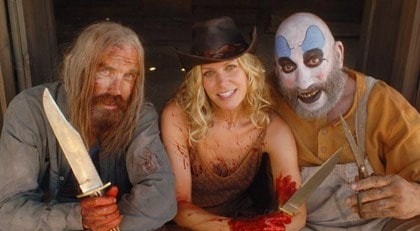
Why are Murderhobos bad?
So why are Murderhobos so bad, anyway?
I have no doubt that there’s some exhausting list of reasons out there, but most reasons really boil down to three root issues. These root issues are all interconnected which is a big factor in why a Murderhobo problem can very quickly spiral out of control if left unchecked.
Also, keep in mind that this is specifically as it relates to the toxic Murderhobo character that we covered earlier in this article.
If it’s a combat-heavy, “kick in the door,” beer-and-pretzels type group of players, there is absolutely no harm in that. That is just one of many styles of D&D campaign out there!
Selfishness
The primary issue with Murderhobos is that their playstyle is inherently selfish.
By refusing to engage in the story and actively derailing it with random acts of ultraviolence, the Murderhobo is putting their specific idea of fun ahead of the group’s.
Ideally, the campaign caters to all of the players’ specific type of fun. Unfortunately, the Murderhobo’s behavior makes it so that anything that isn’t combat is largely off the table.
By turning every single situation into a combat situation whether prompted or not, the Murderhobo is forcing the campaign and all of the players in it to go one way: the Murderhobo’s.
As mentioned earlier, the DM will eventually stop trying to prepare interesting adventure hooks or NPCs. After all, why bother?
Meanwhile, the players (especially those who built characters not based entirely around combat) begin to feel ignored. If a player starts wondering “why am I even showing up?” it’s very difficult to get them back. From there, you risk the group falling apart.
As for loot, the Murderhobo will almost always push to get the lion’s share of the treasure or (at least) the best finds from the loot haul. Even if they can’t fully benefit from the item, they might immediately consider selling it instead of seeing if someone else in the party could use it.
Quick story:
I remember staring dumbfounded at the Murderhobo in one of my old groups.
Finding a powerful item clearly meant for a Druid, i.e. my character, he complained that we didn’t find the gear he wanted but reasoned that he could sell the item. Rather than hand the item to my character, he insisted that I had to buy it from him.
I picked it from his corpse once we finished the boss fight in the next room.
Contagious Behavior
Because the Murderhobo has forced the campaign to exclusively cater to one style of play, the other players have a choice to make.
They can:
- Make Murderhobo characters themselves.
- Quit.
- Resign themselves to just kind of sit there for 4-5 hours.
In my experience, it’s usually either option 1 or 3. They don’t want to quit the campaign because they WANT to play D&D and they WANT to visit their friends.
Players who go with option 3 then spend most of the session on their phone, doodling, or something else. The game becomes a secondary task for them despite them being at the table.
Otherwise, players decide that “if you can’t beat them, join them.” If they don’t make a Murderhobo character themselves, they at least have to make one that’s able to survive the inevitable chaos that the Murderhobo causes.
There might have been a wide spread of character types in the initial party. Now, everyone’s having to play characters that are meant to survive random insanity created by the Murderhobo instead of the characters that they wanted to play.
They Set a Ceiling on the Story’s Potential
Murderhobos tend to push things as far as they possibly can. Even if their character dies, it’s a sure bet that their next character is probably going to be basically the exact same way.
By refusing to engage with the story while also actively sabotaging it, the Murderhobo puts a ceiling on what that story can be.
Even in situations where the Murderhobo isn’t actively rampaging and causing trouble for the rest of the group, there’s always a certain tension. Everyone knows that it can and will start back up again at any moment. As a result, the other players stop engaging with the story as much.
Admittedly, this core issue is mostly the natural result of the first two. However, I think it’s a distinct enough point that it has to be made.
If the Murderhobo is allowed to continue their behavior, the adventure won’t just magically get better. If anything, it’s more likely to get worse.
I’ve sat at tables in my younger days that turned into “watch the Murderhobo play D&D for 6+ hours.” It wasn’t fun at all but I kept showing up in hopes that it would get better. The DM would talk about these cool ideas he had for adventures and dungeons, but those ideas would ultimately never happen at the table.
Because our Murderhobo was particularly set off by having to pay fees to dock our ship, each session was basically:
- Arrive in a new port.
- “WHAT DO YOU MEAN I HAVE TO PAY?!”
- 6+ hours of combat against the entire town’s guard force
- Sail away to a new port where they wouldn’t know us.
- Do it all again next session.
15 years later, it still breaks my heart that our DM didn’t get to use more than a handful of his ideas.
Conclusion – Anatomy of a Murderhobo
Thank you for joining me in this anatomy of the infamous Murderhobo specimen.
I hope that learning the characteristics of Murderhobos and the impact that they have on your game and group will help you better spot them.
It’s probably safe to say that we’ve all had some kind of experience with a Murderhobo in the party at some point or another. If you’ve got a story about your experience with a Murderhobo in your group, I’d love to read it in the comments!
Want to stay up to date with all the latest DM tips, player guides, reviews and more from Tabletop Joab? Sign up for my newsletter below!

